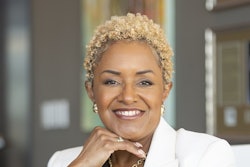Back in February, more than 1,000 practitioners from hundreds of colleges across the nation gathered in Orlando, Florida, to exchange evidence-based approaches to accelerating student success and equity.
 Lumina Foundation CEO Jamie Merisotis delivers a keynote address at the DREAM 2024 conference.
Lumina Foundation CEO Jamie Merisotis delivers a keynote address at the DREAM 2024 conference.
From the conference’s opening panel to workshops and breakout sessions held throughout the four-day event, the importance of centering equity was a central theme of the conference. There was also a robust focus on the humanities.
“ATD is not just a conference,” says Dr. Karen A. Stout, who has led the organization since 2015. “There are cohorts and special groups,” she says, adding that, for example, the visibility of tribal colleges as valued members of the network for the past seven years has helped to propel the organization’s focus on equity and student success.
Thanks to funding from The Kresge Foundation, ATD has partnered with The Siyaphumelela (“We Succeed”) initiative to enhance South African universities’ data capacity to enhance student success. Over the past decade, the initiative has expanded from five initial participating universities to 17; a delegation of South African educators traveled to this year’s conference to learn and to share best practices.
At a time when some organizations and associations have opted to boycott holding their convenings in Florida — the battleground in the ongoing fight to dismantle diversity, equity, and inclusion initiatives — Stout says that it was particularly important for ATD to show up in the Sunshine State this year.
“This is a values-based decision,” she says, adding that there was quite a bit of concern and angst, but ultimately, key stakeholders rallied behind the idea to move forward with their support to hold the conference there. “We are not leaving Florida behind. We are not leaving our colleges in Florida behind, and most importantly, we’re not leaving our students in Florida behind.”
Stout — who has been the driving force behind ATD’s success over the last nine years, says that she is encouraged by the growth of the organization — which now boasts more than 300 colleges as part of its network — with nearly 25% of the nation’s community colleges having been through Foundations of Transformation, ATD’s core three-year program led by expert coaches, designed to build foundational capacities for student success.
More than 50% of this year’s registrants were first-time ATD attendees, an indication, says Stout, that “we’re still young in our movement.”
 Community College of Aurora President Dr. Mordecai Brownlee with ATD President Dr. Karen A. Stout and Dr. Stephanie Fujii, president of Arapahoe Community College, at this year’s DREAM 2024 conference.
Community College of Aurora President Dr. Mordecai Brownlee with ATD President Dr. Karen A. Stout and Dr. Stephanie Fujii, president of Arapahoe Community College, at this year’s DREAM 2024 conference.
Even after the three-year commitment, many institutions pursue other areas, opting to delve deeper into exploring issues around teaching and learning, holistic supports for their campuses, or student enrollment.
ATD’s existence is a result of the Lumina Foundation’s invitation to select organizations to form a partnership focused on community colleges back in 2003. At this year’s conference, Lumina’s CEO, Jamie Merisotis, delivered a keynote address, affirming the success of ATD over these past 20 years.
“It’s rare that philanthropy stays with an idea for a long time,” says Stout.
Stout says Lumina, Kresge, Ascendium, the Bill and Melinda Gates Foundation, and the financial support from MacKenzie Scott have been instrumental in pushing the organization’s work forward.
Seasoned coaches, including the addition of new coaches who are practitioners, have helped to diversify ATD’s offering and look much more like the diverse population that community colleges traditionally serve.
“I think that is injecting new energy and new thinking into the movement,” says Stout, who previously led Montgomery County Community College in Pennsylvania from 2001 to 2015.
“We have a whole new generation of young leaders that need supports like ATD,” she says.
Dr. Mordecai Brownlee, president of Community College of Aurora, is one of those relatively new college presidents.
“For the past 20 years, Achieving the Dream has served as the premier organization shining a light on the responsibility institutions of higher education have to address the academic and non-academic needs of its low-income students, students of color, and first-generation college students,” says Brownlee. “I can think of no other organization that has consistently placed equity for all students at the forefront and had such a worldwide impact as ATD has.”
Community College of Aurora is the first institution in the Colorado Community College System to join the ATD Network.
“Our partnership with ATD has led to systematic transformation throughout our institution and has unified our institutional approach towards advancing equity with our students and local community,” says Brownlee.
The uniqueness of ATD is that faculty and senior administrators — most notably the college president — often attend the conference together and work collectively on developing a plan to improve outcomes at their institution. That design has stayed central to the work of the organization over the past two decades.
One college president brought a team of 30 to the conference. Another had a team of 25.
When Stout asked the presidents what their biggest takeaway was from this year’s convening, their answer was simple: validation and the feeling that they are on the right track.
“When you’re here, you see all of the energy and you feel validated and you go back to your campus and realize change is hard at the local level,” explains Stout, who says she remains hopeful by what she sees, particularly at the state level, to support community colleges with new and innovative funding models.
“I see states being bolder in creating policy and funding frameworks that will help colleges to stay focused on student success,” she continues.
The emphasis on dual enrollment, she notes, has proven to be a game-changer.
“Our colleges are thinking much more intentionally about not just responding to high schools, but reaching students that otherwise would not have postsecondary education pathways,” says Stout. “I think community colleges can really drive, with partnerships with the high schools, those equitable gains.”



















